Heather N. Kolich, ANR Agent, UGA Extension Forsyth County
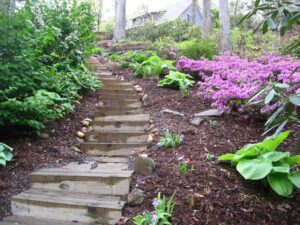
Nature is generally successful in keeping our North Georgia hills and mountainsides stable and covered with verdant plant life. In home landscapes, however, slopes and hills can present challenges.
When developing a management plan for hills, we need to address all the normal considerations of landscaping, such as soil and drainage, sun exposure, irrigation, and good design. To that, we must add the dynamics of slope, erosion, and stormwater runoff.
Slope determination and implications
Slope can be stated as a ratio or percent and is calculated by measuring the height of the rise over the distance of the horizontal run. To get the percent of slope, divide the number of feet that the hill goes up by the number of feet of horizontal distance covered, and then multiply by 100. For example, if the hill rises 8 feet over a distance (run) of 40 feet, the equation is:
(8 ÷ 40) x 100 = 20%. Expressed as a ratio, this slope would be 8:40, which reduces to 1:5.
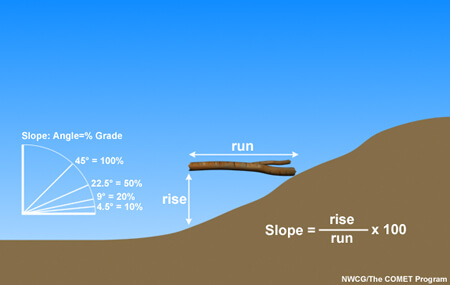
A gentle slope is any slope less than 5% (1:20, or a rise of one foot over a horizontal run of 20 feet) and can be planted and managed with little consideration for the slope. From 8-16% (1:12-1:6), the slope is categorized as moderately steep, and walking, gardening, and water retention are more difficult. Steep slopes (20% or 1:5 and above) have special planting requirements. When the slope reaches 30% (1:3), it is too steep to mow. A slope of 50% or steeper is unlikely to support plant growth.
Erosion and stormwater control options
We have several effective options for controlling soil erosion and stormwater runoff on slopes.
- Retaining walls and terracing secure soil and create level planting areas.
- Plant roots hold the soil and soak up rainwater while stems and leaves divert and slow the flow of water down the slope.
- Mulch covers soil to protect it from wind and rain erosion.
- Strategically placed rocks, boulders, bricks, and timbers move water flow across the slope like switchbacks on a mountain road.
- Coir logs and straw wattles slow and absorb stormwater, allowing it to soak into soil on the slope.
- Planting the top of the slope captures rainfall and reduces the volume of water rushing down the slope.
- On unplantable slopes, permanent synthetic mats hold soil in place.
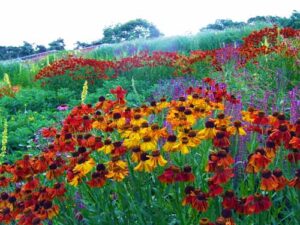
Combining several of these erosion solutions improves functioning and creates appealing landscapes.
Plant selection and design
Plants are the workhorses and focal points of hillside landscapes. Using a mix of native grasses, groundcovers, herbaceous perennials, shrubs, vines, and trees gives the landscape visual appeal by incorporating a variety of sizes, heights, colors, textures, forms, and movement. Underground, the different roots – shallow, deep, fibrous, and spreading – work at multiple levels to secure soil, scavenge nutrients, and take up water.
Select plants that are low-maintenance and adapted to thrive in the existing conditions of the planting area. Because rainwater runs down slopes quickly, plants at the top of the hill should be drought tolerant. Consider installing drip irrigation or soaker hoses to provide necessary irrigation for plant establishment and during dry spells. If the bottom of the hill tends to stay wet, plants located there should be adapted to wet soil. Thriving plants and good mulch coverage will suppress weeds. Select a coarse-textured, natural mulch, such as shredded bark or leaf mold, that won’t roll down the slope. Some themes that utilize low-maintenance plants include:
- Rock garden
- Pollinator garden
- Native plant garden
- Wildflower prairie
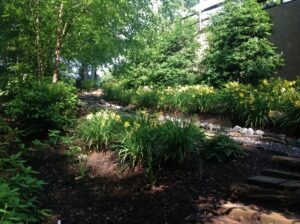
Viewpoint is a consideration when planting a hillside garden. If viewing from the bottom of the slope, plants with the same height will all be visible as they march up the slope. Still, taller plants should be uphill of smaller plants. Keep scale in mind, as well, so that plants on the next level up don’t appear to tower over those below. If viewing the garden from the top of the slope, select shorter plants for the top and locate taller plants toward the bottom.
Site preparation and planting
When planting on a slope, the goal is to disturb the soil as little as possible; however, soil preparation and weed removal are essential for new plants to establish.
Transplants give fast coverage with less soil disturbance than seeds because they can be planted into existing mulch coverage or dead vegetation. Consider staking in some biodegradable coir logs or straw wattles at different levels across the slope. These will help define the planting areas and capture water for a slow release to soil in the plant root zones. Alternatively, use stones, bricks, or other materials to hold soil in mini terraces that are sized 2-3 times wider than the root ball or plant container. Stagger plants across the width of the slope in groups and loose rows. Stagger plant height and leaf types as well. This is both visually appealing and functional because leaves intercept raindrops and reduce their eroding impact on soil.
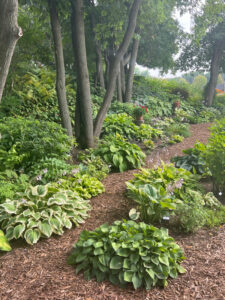
Seeding is more economical for large areas, but the soil must be cleared of all vegetation to get good seed-to-soil contact for germination. Cover seeds with straw to keep them from washing downhill, and starting from the top, mist the slope frequently to keep the soil moist until seeds begin to sprout.
For plant suggestions, see UGA Extension’s Native Plants for Georgia series parts I-IV, and publications Groundcovers and Groundcovers for Shaded Landscapes in North Georgia.